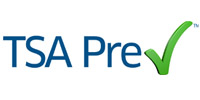
TSA employs risk-based, intelligence-driven operations to prevent terrorist attacks and to reduce the vulnerability of the Nation's transportation system to terrorism. These security measures create a multi-layered system to strengthen aviation security from the curb to the cockpit and extend to surface transportation modes.
 The
The  pilot is a passenger pre-screening initiative for travelers who volunteer information about themselves prior to flying in order to potentially expedite screening at the checkpoint. Eligible participants include certain frequent flyers from American Airlines and Delta Air Lines as well as existing members of U.S. Customs and Border Protection's (CBP) Trusted Traveler programs including Global Entry, SENTRI, and NEXUS who are U.S. citizens and are flying on participating airlines domestically at five participating airports. TSA plans to expand
pilot is a passenger pre-screening initiative for travelers who volunteer information about themselves prior to flying in order to potentially expedite screening at the checkpoint. Eligible participants include certain frequent flyers from American Airlines and Delta Air Lines as well as existing members of U.S. Customs and Border Protection's (CBP) Trusted Traveler programs including Global Entry, SENTRI, and NEXUS who are U.S. citizens and are flying on participating airlines domestically at five participating airports. TSA plans to expand  to additional airlines and airports in 2012.
to additional airlines and airports in 2012.
- The Known Crewmember pilot program allows expedited screening for uniformed pilots from 22 airlines who show two forms of identification at the checkpoint.
- The Behavior Assessor pilot programs build on the current Screening of Passengers by Observation Techniques (SPOT) by employing specialized behavioral analysis techniques to determine if a traveler should be referred for additional screening at the checkpoint. This additional interaction, used by security agencies worldwide, enables officers to to identify potentially high-risk individuals.
- Modified screening procedures were implemented to provide more options to resolve alarms while screening passengers 12 and under, resulting in a reduction – though not elimination – of the need for a physical pat-down for children.
- Air cargo is more secure than it has ever been with 100 percent of cargo on flights departing U.S. airports and 100 percent of identified high risk international inbound cargo undergoing screening. TSA continues to work closely with our private sector and international partners to further strengthen international inbound air cargo security.
- The Transportation Security Grant Program (TSGP) and the Intercity Passenger Rail Security Grant Program have strengthened the resilience of mass transit and passenger rail critical infrastructure against potential terrorist attacks by providing more than $220 million to owners and operators of transit systems including intracity buses, commuter buses, ferries, Amtrak, and other commuter systems in FY 2011.
- In 2011 TSA conducted the risk and security assessments for 26 bridges and 47 tunnels; 55 Baseline Assessment for Security Enhancement (BASE) assessments on critical mass transit and passenger rail systems; and 65 physical security inspections of facilities identified as essential to the operation of the nation's most critical pipeline systems.
- DHS continued to expand the number of Visible Intermodal Prevention and Response Team operations in 2011, conducting more than 9,300 operations in coordination with federal, tribal, state, and local law enforcement and transportation security stakeholders in more than 500 communities.
